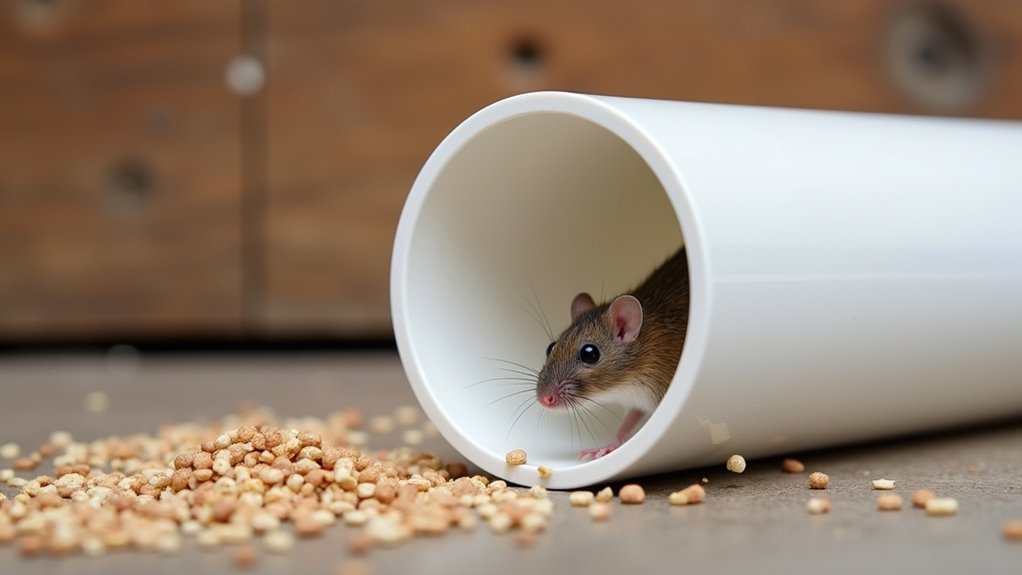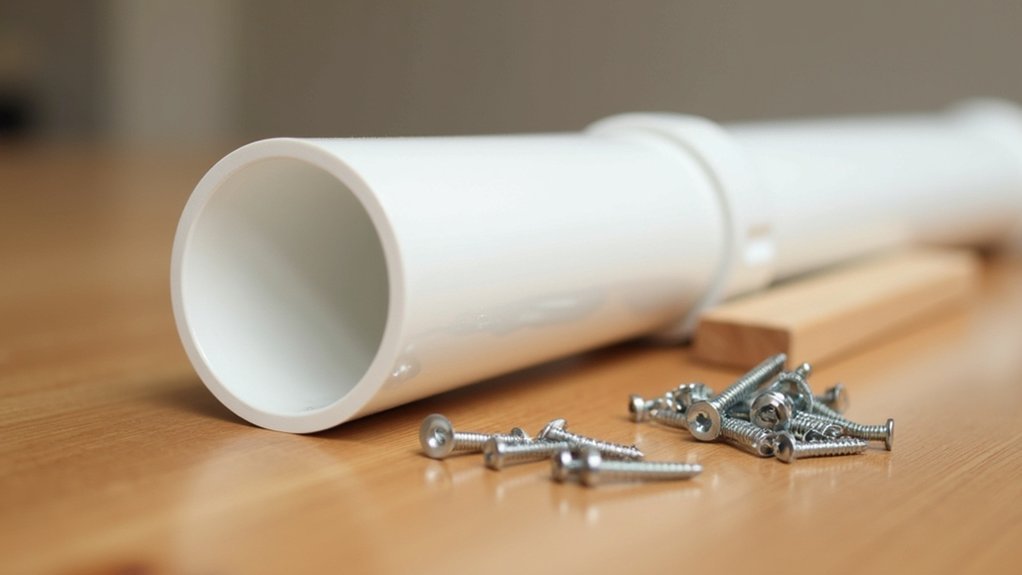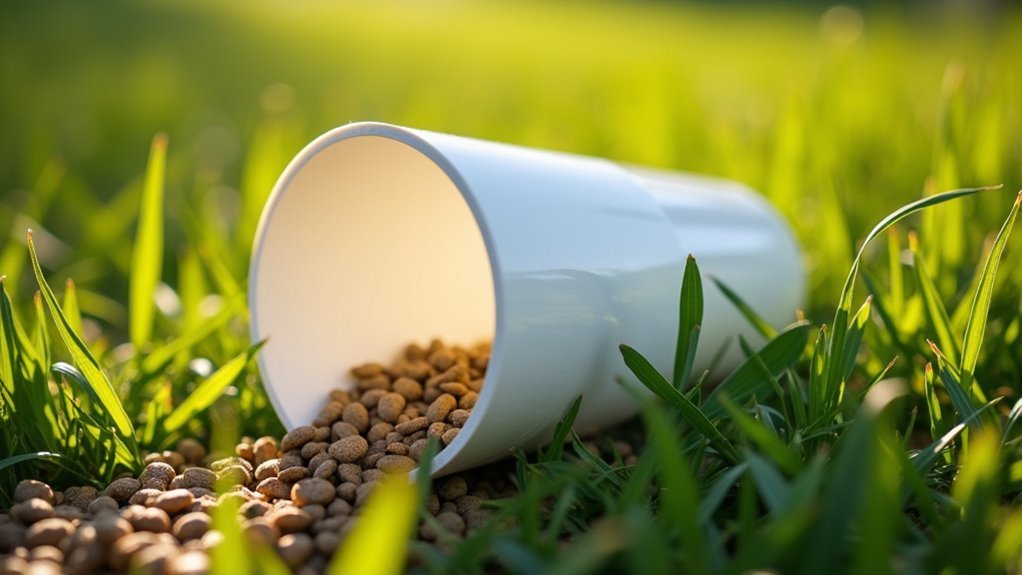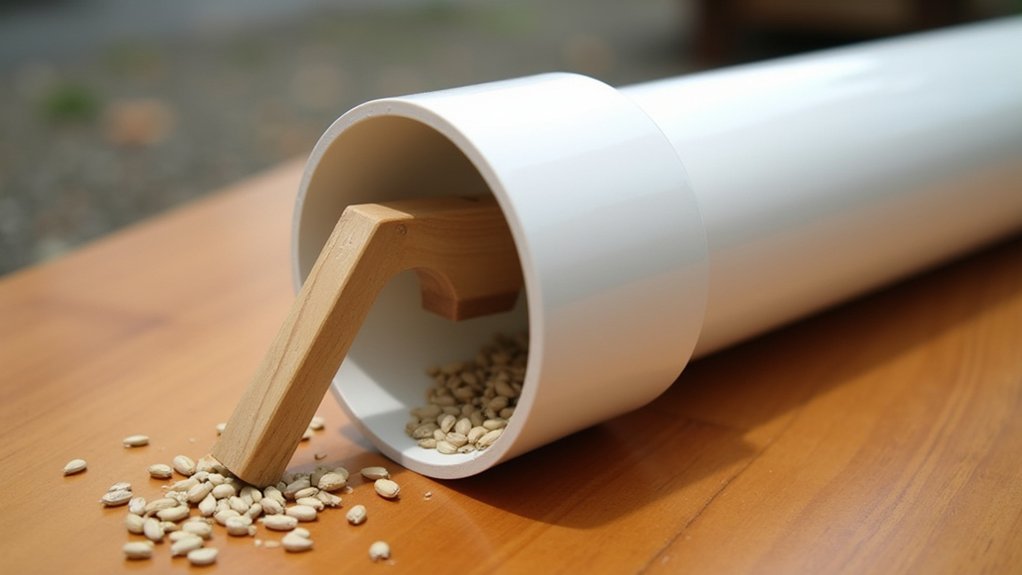PVC pipe makes perfect mouse traps due to its durability, smooth interior, and cost-effectiveness. You’ll appreciate how the weather-resistant material works both indoors and outdoors while ensuring humane capture with no sharp edges. Assembly requires just basic tools and household items, plus the lightweight design lets you easily reposition traps in high-activity areas. Its non-toxic properties keep children and pets safe. Discover how simple PVC components can transform your rodent control strategy.
Advantages of PVC Pipe in Rodent Control

While many homeowners struggle with expensive or ineffective mouse traps, PVC pipe offers a superior alternative for rodent control.
You’ll appreciate the durability and weather resistance that makes these traps functional in any environment, whether indoors or exposed to the elements.
The smooth interior of PVC pipe creates a humane trapping solution without sharp edges that might harm captured mice.
You can easily assemble these mouse traps using common household items, saving money while effectively managing pest issues.
PVC’s lightweight nature means you can reposition your traps whenever needed to target high-activity areas.
Parents and pet owners will value the non-toxic properties that make these rodent control devices safe to use throughout your home, giving you peace of mind while addressing unwanted visitors.
Essential Materials and Tools for Your PVC Trap
What exactly do you need to build an effective PVC pipe mouse trap? Start with PVC pipe measuring 2-4 inches in diameter, a clean out adapter for easy access, and a 90-degree street elbow that serves as the entrance.
You’ll also need hardware components including a bolt, washers, and nuts to create a vent viewer for monitoring and baiting without disturbing the trap.
For assembly, you’ll only require basic tools—a screwdriver and wrench—which you likely already have in your toolkit.
Choose solid brass or stainless steel components for their durability and corrosion resistance, ensuring your mouse trap remains functional long-term.
While cement can be used for permanent fittings, leaving connections uncemented allows for easier disassembly when adjustments or maintenance become necessary.
Step-by-Step Assembly Guide

Three simple phases make up the PVC pipe mouse trap assembly process.
First, construct the main structure by connecting the test tee fitting with a clean-out adapter, which creates an accessible service entrance for your trap. Take time to guarantee all connections are secure.
Next, attach the 90-degree street elbow to form the entrance point. This critical component should be sized appropriately—large enough for mice but too small for pets to access.
Finally, enhance functionality by installing the vent viewer. Secure a bolt to a snap-in drain, creating a window that allows you to monitor activity and bait the trap effectively.
When ready to use, simply unscrew the clean-out door, insert your baited mousetrap, and close the system. This design guarantees humane capture and easy mouse retrieval.
Baiting Techniques That Actually Work
Success with PVC pipe mouse traps depends greatly on your baiting strategy. Peanut butter is your top choice for bait, as its strong aroma and sticky consistency keep mice lingering long enough to trigger the trap.
Peanut butter’s sticky consistency and powerful aroma make it the ultimate bait for PVC pipe mouse traps.
Dark chocolate offers another effective option that rats and mice find irresistible due to its sweet scent.
If you’re looking for alternatives, try sunflower seeds. Their high fat and protein content naturally appeal to foraging rodents.
Always place your bait at the far end of the PVC pipe trap to guarantee the mouse fully enters before triggering the mechanism.
Don’t forget to refresh your bait regularly, especially in warm or outdoor settings. Fresh bait maintains its potent smell, considerably increasing your chances of catching those unwanted visitors.
Strategic Placement for Maximum Effectiveness

Now that you’ve perfected your baiting technique, the location of your PVC pipe traps will determine your overall success rate.
Position traps along walls and corners where mice typically travel in straight lines, hugging the structure for security.
Place traps near your kitchen and pantry areas where food attracts these hungry intruders. Make sure the trap entrance remains unobstructed and low to the ground for easy mouse access.
Don’t rely on just one trap—deploy multiple units throughout your home to cover different activity zones. Mice can be active in various areas simultaneously, so thorough coverage is key.
Monitor your traps regularly and be prepared to relocate them if you notice changing mouse activity patterns. These adaptable creatures may alter their routes, requiring you to adjust your strategy accordingly.
Humane Capture Considerations
PVC pipe mousetraps offer a no-injury design that prevents harm to mice during capture, allowing you to manage pests without causing suffering.
Your trapped mice will experience less panic in these devices, thanks to the absence of painful springs or snapping mechanisms found in traditional traps.
You’ll appreciate the ethical advantage of providing a relatively stress-free holding environment while still effectively addressing your rodent problem.
No Injury Design
While traditional mousetraps often cause pain or injury to rodents, the PVC pipe trap stands out as a humane alternative that prioritizes animal welfare.
You’ll appreciate that these innovative traps operate without snapping levers or springs, eliminating the risk of physical harm to mice during capture.
The trap’s thoughtful design creates a calm environment that greatly reduces the stress mice typically experience in conventional traps.
You can easily operate the mechanism and quickly release your captured visitor, minimizing its time in captivity.
What makes this approach particularly appealing is that you’re using common household items to create a solution that’s both effective and gentle.
Users consistently report success in capturing rodents without causing harm, confirming that you don’t need to choose between effectiveness and compassion when managing unwanted house guests.
Stress-Free Holding Environment
Once captured in the PVC pipe trap, mice experience considerably less stress than in traditional traps, thanks to the enclosed, dark environment that mimics their natural hiding places. The absence of threatening springs or snapping mechanisms keeps rodents calm until release time.
| Stress-Reducing Feature | Benefit | Impact on Rodent |
|---|---|---|
| No snapping mechanisms | Prevents injury | Lower physical stress |
| Dark, enclosed space | Mimics burrows | Calming environment |
| Simple peanut butter bait | Encourages entry | No fear of approach |
| Quick release design | Minimizes captivity | Reduces detention time |
You’ll appreciate that this humane approach allows for effective pest control without causing unnecessary suffering. The rodents remain calm during capture, making the release process easier and more humane for both you and the mouse.
Preventing Escape: Design Elements That Matter
When constructing your PVC pipe mouse trap, you’ll want to prioritize the smooth interior walls that prevent mice from finding grip points or chewing opportunities for escape.
The addition of a one-way entry mechanism creates a point-of-no-return that allows mice to enter but blocks their exit path completely.
These two design elements work together to dramatically increase your capture success rate while minimizing the chance of overnight escapes.
Smooth Interior Walls
The smooth interior walls of PVC pipes represent a critical design element that prevents mice from escaping once captured. When you’re designing a humane trap, this feature guarantees that mice can’t gain the traction they need to climb out, unlike textured materials that provide footholds.
- The slick surface prevents mice from utilizing their natural climbing abilities.
- Consistent diameter throughout eliminates potential leverage points for escape.
- Non-porous material doesn’t absorb odors, reducing stress for captured animals.
- Absence of sharp edges or obstructions minimizes risk of injury during capture.
- Interior smoothness facilitates easy movement into the trap, but prevents the reverse journey.
This thoughtful design element greatly enhances capture efficiency while maintaining the humane aspect of temporary containment.
One-Way Entry Mechanisms
Effective PVC pipe mouse traps rely on ingenious one-way entry mechanisms that allow mice to enter freely but prevent their escape afterward.
The secret lies in the tapered entrance design that narrows once the mouse has passed through, making it impossible to exit the same way.
You’ll find that most successful designs incorporate weighted doors that automatically close behind the rodent, creating a secure seal.
This simple yet clever mechanism works in tandem with the smooth interior walls you’ve already installed, giving mice no footholds to climb back toward the entrance.
The lightweight yet durable nature of PVC materials provides ideal support for these entry systems without compromising functionality.
When properly constructed, your one-way trap will safely contain mice until you’re ready to release them elsewhere.
Customizing Your Trap for Different Mouse Species
Successfully targeting different mouse species requires thoughtful adjustments to your PVC pipe trap design.
You’ll need to take into account species-specific behaviors and preferences to maximize your trap’s effectiveness. By making simple modifications, you can create a versatile solution for various mouse problems.
- Adjust entrance dimensions—narrower openings (½ inch) for deer mice, slightly wider (¾ inch) for house mice
- Select appropriate bait—seeds and grains for field mice, peanut butter or chocolate for house mice
- Position traps strategically along walls, near nesting areas, or identified runways based on species movement patterns
- Add species-specific attractants like vanilla extract for deer mice or herbs for field mice
- Monitor and adapt your design based on capture rates, adjusting features that work best for your specific infestation
Cleaning and Maintenance Tips
Proper maintenance of your PVC pipe mouse trap guarantees its continued effectiveness and extends its useful life.
Regular upkeep of PVC pipe traps ensures ongoing pest control success while maximizing durability and performance.
After each catch, thoroughly clean the trap with soap and water to remove residues that might deter future mice.
Regularly inspect your trap for damage, especially at joints and openings where mice could potentially escape.
Apply a disinfectant solution to the interior surfaces to eliminate bacteria, particularly after multiple captures.
Don’t forget to remove all bait remnants promptly.
Leftover peanut butter or other food can attract unwanted pests and reduce the trap’s effectiveness over time.
When not in use, store your trap in a dry, clean location.
This prevents mold and mildew growth that could compromise the PVC material and ultimately affect the trap’s functionality.
Troubleshooting Common PVC Trap Issues
If your PVC mouse trap isn’t working properly, you’ll need to check for chew marks and reinforce vulnerable spots with metal components or wire mesh.
Make certain the entry points are small enough to prevent escape but large enough to entice mice, positioning bait at least three inches from the entrance to encourage full entry.
You might also need to adjust your trap’s location to high-traffic areas along walls or near food sources where mice typically travel.
Chewing Concerns Addressed
Although PVC pipes offer durability and moisture resistance, many DIY trap builders worry about mice chewing through their carefully constructed devices.
Research shows that while chewing can occur, it typically takes time—giving you ample opportunity to check traps and release captured mice before significant damage happens.
To minimize chewing risks:
- Inspect traps at least twice daily to prevent extended confinement
- Reinforce vulnerable areas with metal mesh or wire for added protection
- Use highly attractive bait like peanut butter to reduce frustration-based chewing
- Design traps with smooth interior surfaces that provide fewer gripping points
- Consider thicker PVC piping for critical trap components that might experience stress
Bait Placement Tips
Where you place bait in your PVC pipe trap can make the difference between catching mice consistently and experiencing frustrating failures.
Position your bait at the far end of the pipe, forcing mice to fully enter the trap before reaching their reward. This guarantees proper triggering of the trap mechanism.
Secure the bait firmly to prevent mice from grabbing it without setting off the trap. Peanut butter works excellently as it’s both sticky and aromatic, but don’t hesitate to experiment with chocolate or sunflower seeds if your mice seem uninterested.
Remember to check and refresh bait regularly—stale offerings won’t attract wary rodents.
For maximum effectiveness, place your baited traps along walls or near food sources where mouse traffic is heaviest. These high-activity zones dramatically increase your capture rate.
Entry Design Fixes
Why do some PVC pipe traps fail despite proper baiting? Often, the culprit is poor entry design. The entrance is your trap’s most critical component, determining whether mice enter willingly and stay captured.
- Size your entrance carefully—too large allows escapes, too small prevents entry (a 1″ flush bushing works perfectly).
- Reinforce entry points with metal mesh to prevent mice from chewing their way out.
- Create angled entrances that make it easy to enter but difficult to exit.
- Add internal baffles to create a one-way passage system that prevents backtracking.
- Position the entrance at floor level where mice naturally travel, making it more inviting.
Check your trap regularly for signs of tampering or gnawing around the entrance.
If mice are avoiding your trap, try repositioning it along walls where they typically travel.
Alternative PVC Designs for Specific Scenarios
When facing unique rodent control challenges, standard PVC pipe traps may need modification to maximize effectiveness. You can customize pipe diameter and length based on whether you’re targeting mice or the larger voles, ensuring appropriate sizing for your specific pest problem.
Consider adding a vent viewer to monitor captured rodents without opening the trap, reducing stress for the animals while allowing you to check trap status easily.
For areas with limited access, try incorporating a clean-out adapter design that enables convenient baiting and retrieval while maintaining security.
In environments where rodents have previously damaged traps, upgrade to solid brass or stainless steel fittings for superior durability and chew resistance.
If pets roam your property, install flush bushings to create smaller entrances that admit mice but exclude larger animals.
Frequently Asked Questions
Can Mice Chew Through PVC Pipe?
While mice can chew through PVC pipe, it’s much harder than softer materials. You’ll find they’ll struggle with PVC’s durability, giving you time to check traps and release captured mice before damage occurs.
Why Are Mice Not Getting Caught in Traps?
Your mice aren’t getting caught because you’ve likely placed bait improperly, positioned traps in low-activity areas, chosen the wrong trap design, set them in disturbed environments, or haven’t maintained them regularly enough.
What Is the Most Effective Mouse Trap?
The most effective mouse trap is the humane PVC pipe trap. You’ll find it captures mice without injury using simple bait like peanut butter. They’re stress-reducing for mice and safer for you to handle.
How Can I Make My Mouse Trap More Effective?
Place your trap where you’ve seen mice activity, use peanut butter as bait, guarantee the entrance is mouse-sized, build with smooth PVC pipe, and check your trap regularly to release captured mice promptly.
In Summary
You’ve now discovered why PVC pipe makes the perfect DIY mouse trap. It’s affordable, customizable, and highly effective when properly set up. Remember to check your traps regularly, clean them thoroughly between uses, and adjust your baiting strategy if needed. With these simple tubes, you’ll maintain a rodent-free home without breaking the bank or using harsh chemicals.





Leave a Reply